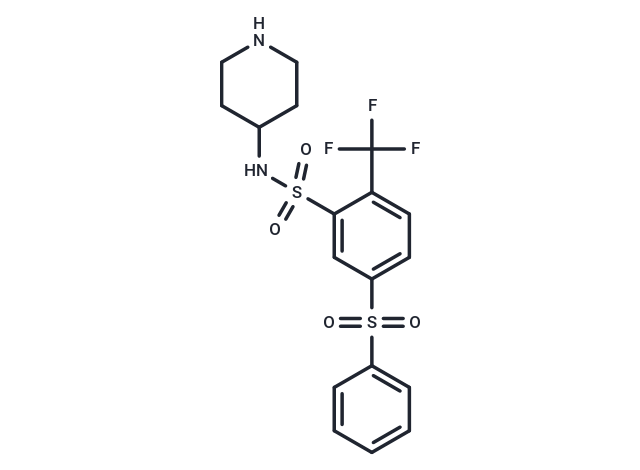Shopping Cart
- Remove All
 Your shopping cart is currently empty
Your shopping cart is currently empty

WAY 316606 is an inhibitor of the secreted protein sFRP-1, an endogenous antagonist of the secreted glycoprotein [Wnt].

| Pack Size | Price | Availability | Quantity |
|---|---|---|---|
| 5 mg | $43 | In Stock | |
| 10 mg | $71 | In Stock | |
| 25 mg | $128 | In Stock | |
| 50 mg | $215 | In Stock | |
| 100 mg | $347 | In Stock | |
| 200 mg | $497 | In Stock | |
| 1 mL x 10 mM (in DMSO) | $48 | In Stock |
| Description | WAY 316606 is an inhibitor of the secreted protein sFRP-1, an endogenous antagonist of the secreted glycoprotein [Wnt]. |
| Targets&IC50 | SFRP1:0.5 μM |
| In vitro | The EC50 of WAY-316606 for Wnt-Luciferase Activity from U2-OS Cells is 0.65 μM[1]. WAY-316606 binds to the secreted frizzled-related protein (sFRP)-1 inhibitor with a KD of 0.08 μM and inhibits sFRP-1 with an EC50 of 0.65 μM. WAY-316606 also binds to sFRP-2, albeit over 10 times weaker with a KD of 1 μM. Using a fluorescence polarization binding assay that employs a fluorescent probe compound and purified human sFRP-1 protein in a competitive-binding format, the IC50 for WAY-316606 is 0.5 μM [2]. |
| In vivo | WAY-316606 effectively promotes bone formation, as demonstrated in neonatal murine calvarial assays, with the capability to increase total bone area by up to 60% in a dose-dependent manner, achieving an EC50 of approximately 1 nM. This compound exhibits favorable aqueous solubility, displays moderate to low inhibition of cytochrome P450 isozymes (3A4, 2D6, 2C9), and maintains good stability in both rat and human liver microsomes (t1/2>60 min for each species). Moreover, in female Sprague-Dawley rats, WAY-316606 shows high plasma clearance (77 mL/min/kg, surpassing hepatic blood flow) following a single intravenous bolus dose (2 mg/kg), leading to a swift reduction in plasma drug levels regardless of administration route [2]. |
| Kinase Assay | WAY-316606 binding to purified sFRP is determined by spectroscopy methods. The sFRP-1 or -2 stock solutions are diluted to 1 μM in a buffered solution and the initial fluorescence is measured. Increasing concentrations of WAY-316606 (0 to 50 μM) are added to the protein in the cuvette and incubated for 5 min prior to assessing fluorescence intensity using a Fluoromax-2 fluorometer. In control experiments, the DMSO (vehicle control)-matched buffer solution is used. Fluorescence spectra are scanned in the ratio mode (S/R, signal/reference) to compensate for variations in lamp output as a function of wavelength [2]. |
| Cell Research | U2OS bone cells are infected with recombinant adenovirus 5 (Ad5)?WNT3 at a multiplicity of infection (MOI) of 2, followed by infection with Ad5-sFRP-1 and Ad5-16xTCF-luciferase, each at an MOI of 10. Four hours after infection, the cells are frozen in sterile cryogenic vials at a cell density of 9×106 cells/mL and stored in a ?150°C freezer. For the assay, a vial of frozen cells is thawed, and the cells are resuspended in plating medium [phenol red-free RPMI 1640 medium containing 5% fetal calf serum, 2 mM GlutaMAX-l, and 1% (v/v) penicillin-streptomycin] to a final cell density of 1.5×105 cells/mL. The resuspended cells are then plated in 96-well tissue culture treated plates at a volume of 100 μL of cell suspension/well (i.e., 1.5×104 cells/well). The plates are incubated at 37°C inside a 5% CO2/ 95% humidified air incubator for 5 h or until the cells have attached and started to spread. Prior to the addition of WAY-316606, the medium is replaced with 50 μL/well of phenol red-free RPMI 1640 containing 10% fetal calf serum, 2 mM GlutaMAX-l, and 1% (v/v) penicillin-streptomycin. WAY-316606, or vehicle (typically DMSO), diluted in phenol red-free RPMI 1640 containing 2 mM GlutaMAX-l, and l % (v/v) penicillin-streptomycin are then added to the wells in replicates of 4 wells/dilution and the plates are incubated at 37°C overnight. Dose?response experiments are performed with the compounds in 2-fold serial dilutions from 10000?4.9 nM. After the overnight incubation, the cells are washed twice with 150 uL/well of PBS w/o calcium or magnesium and lysed with 50 μL/well of 1× cell culture lysis reagent on a shaker at room temperature for 30 min. Aliquots of the cell lysates (30 μL) are transferred to 96-well luminometer plates, and the luciferase activity is measured in a MicroLumat PLUS luminometer using 100 μL/well of a luciferase substrate. |
| Molecular Weight | 448.48 |
| Formula | C18H19F3N2O4S2 |
| Cas No. | 915759-45-4 |
| Smiles | FC(F)(F)c1ccc(cc1S(=O)(=O)NC1CCNCC1)S(=O)(=O)c1ccccc1 |
| Relative Density. | 1.50 g/cm3 (Predicted) |
| Storage | Powder: -20°C for 3 years | In solvent: -80°C for 1 year | Shipping with blue ice. | |||||||||||||||||||||||||||||||||||
| Solubility Information | DMSO: 50 mg/mL (111.49 mM), Sonication is recommended. | |||||||||||||||||||||||||||||||||||
Solution Preparation Table | ||||||||||||||||||||||||||||||||||||
DMSO
| ||||||||||||||||||||||||||||||||||||

Copyright © 2015-2025 TargetMol Chemicals Inc. All Rights Reserved.